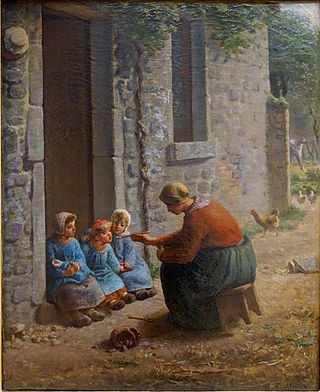
Philippe de Champaigne was a Brabançon-born French Baroque era painter, a major exponent of the French school. He was a founding member of the Académie royale de peinture et de sculpture in Paris, the premier art institution in the Kingdom of France in the eighteenth century.

Simon Vouet was a French painter who studied and rose to prominence in Italy before being summoned by Louis XIII to serve as Premier peintre du Roi in France. He and his studio of artists created religious and mythological paintings, portraits, frescoes, tapestries, and massive decorative schemes for the king and for wealthy patrons, including Richelieu. During this time, "Vouet was indisputably the leading artist in Paris," and was immensely influential in introducing the Italian Baroque style of painting to France. He was also according to Pierre Rosenberg, "without doubt one of the outstanding seventeenth-century draughtsmen, equal to Annibale Carracci and Lanfranco."

Georges Lallemand was a French artist. His name is sometimes given as "Lallemant".

The Palais des Beaux-Arts de Lille is a municipal museum dedicated to fine arts, modern art, and antiquities. It is one of the largest art museums in France.

The Museum of Fine Arts of Lyon is a municipal museum of fine arts in the French city of Lyon. Located near the Place des Terreaux, it is housed in a former Benedictine convent which was active during the 17th and 18th centuries. It was restored between 1988, and 1998, remaining open to visitors throughout this time despite the ongoing restoration works. Its collections range from ancient Egyptian antiquities to the Modern art period, making the museum one of the most important in Europe. It also hosts important exhibitions of art, for example the exhibitions of works by Georges Braque and Henri Laurens in the second half of 2005, and another on the work of Théodore Géricault from April to July 2006. It is one of the largest art museums in France.

The Musée des Beaux-Arts de Strasbourg is the old masters paintings collection of the city of Strasbourg, located in the Alsace region of France. The museum is housed in the first and second floors of the baroque Palais Rohan since 1898. The museum displays works by non-Upper Rhenish artists from between the 14th century and 1871 and by Upper Rhenish artist from between 1681 and 1871. The museum owned 1,934 works as of 31 December 2015, this number has substantially increased since. The old masters from the upper-Rhenish area until 1681 are exhibited in the neighboring Musée de l’Œuvre Notre-Dame.

Arnould de Vuez was a painter of Flemish origin active in Lille from 1680 to 1720.

Eugène Emmanuel Amaury Pineux Duval, better known by the pseudonym Amaury-Duval, was a French painter. He was one of two sons of Amaury Duval (1760–1838) and thus a nephew of the playwright Alexandre-Vincent Pineux Duval.

The Musée des Beaux-Arts de Tours is located in the bishop's former palace, near the cathedral St. Gatien, where it has been since 1910. It displays rich and varied collections, including that of painting which is one of the first in France both in quality and the diversity of the works presented.

Pieter van Mol or Peter van Mol was a Flemish painter known for his history paintings of religious subject matter, and to a lesser extent for his allegorical compositions, genre scenes and portraits. His style was profoundly influenced by Rubens, Abraham Janssens and Artus Wolffort. He was court painter to the King and Queen of France.

The Musée des Beaux-Arts d'Arras is located in the old Abbey of St. Vaast in Arras, in the Nord-Pas-de-Calais, France.

The Musée des beaux-arts de Marseille is one of the main museums in the city of Marseille, in the Provence-Alpes-Côte d'Azur region. It occupies a wing of the Palais Longchamp, and displays a collection of paintings, sculptures and drawings from the 16th to 19th centuries.

St Mary Magdalene in Ecstasy or The Death of St Mary Magdalene is an oil-on-canvas painting by Peter Paul Rubens, completed c. 1619–1620. It shows Mary Magdalene supported by two angels. The painting was produced for the Friars Minor in Ghent. It was seized by French occupation troops in 1794 and taken to Paris, before being allocated to the newly founded Palais des Beaux-Arts de Lille, where it is presently housed.

The Triple Portrait of Cardinal de Richelieu is an oil-on-canvas painting by French artist Philippe de Champaigne, completed c. 1642. The portrait shows Cardinal de Richelieu from three angles: right profile, face on, and left profile. The painting was made as a study for a bust to be made by an Italian sculptor in Rome. It is now held by the National Gallery, London.

Jean-Édouard Dargent, known as Yan' Dargent and in his later years Yann Dargent, was born in Saint-Servais on 15 October 1824 and died in Paris on 19 November 1899. He was a French painter and illustrator. Most of his paintings depicted Brittany.

Berthe Morisot with a Fan is a painting by French artist Édouard Manet, executed in 1874. It belongs to the collection of the Musée d'Orsay, in Paris, but since 2000 it is in loan to the Palais des Beaux-Arts de Lille.

The Beakful, in French, La Becquée, or Woman Feeding Her Children is an oil-on-canvas painting by French artist Jean-François Millet, made in 1860. It is held at the Palais des Beaux-Arts de Lille.

The Tribute Money is an oil on canvas painting by the Flemish-French painter Philippe de Champaigne, created c. 1663–1665. It is held at the Montreal Museum of Fine Arts.


















